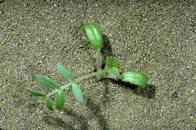|
Walnut
> Year-Round IPM Program > In-Season
Activities > Survey for Weeds
 Walnut Walnut
Survey
for Weeds—Late Spring
By surveying weeds in late spring, you can identify species
that escaped earlier control efforts, and you will know which
perennials are present and which summer annuals are emerging.
If herbicides were used this information will help determine
the need to switch herbicides.
Weeds in tree rows must be managed. Annual
weeds in row middles may be beneficial but before shaking weeds
must be managed to provide a clean and smooth orchard floor.
Record your weed observations in order
to make weed management decisions. Keep these records
so that you can track weed population information from year to
year to better understand ongoing weed control problems such
as resistance.
How to survey your orchards
- Survey your orchard in late spring or early summer, after
summer annuals have germinated.
- If you use cultivation for weed control, monitor at least
2 weeks before you plan to cultivate.
- Check the ground cover in row middles for perennial
seedlings. Check for regrowth of perennials a few weeks
after cultivation.
- Sketch a diagram of the orchard and mark areas where perennials
are found.
- Indicate the growth stage of the weed on the form (seedling
or mature).
- Rate infestation either using a numeric scale from 1 to 5
(1 being the lightest), or using “light,” “medium,” or “heavy.”
- Record your results (sample late-spring weed
survey form—.
Survey information collected over a period of years tells you
how weed populations change and how effective your management
operations have been over the long term. Keep these records so
that you can track weed populations from year to year to
better understand ongoing weed control problems such as resistance.
Important links
|


